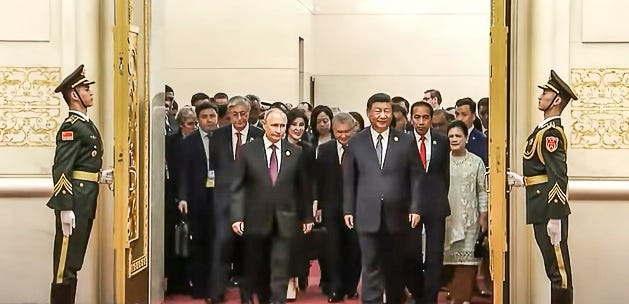Warm welcome all…
This post was almost finished… then we got the news of Li Keqiang’s 李克强 death. I have now seen a dozen or more obits since yesterday—but the most revealing of his trials and tribulations so far, has been the piece in VoA (chinese) by Deng Yuwen 邓聿文, formerly on the editorial team at the Central Party School journal Study Times 学习时报, now resident in the US. I will send a translation in a following post.
Philippa
An already packed agenda in Beijing has been complicated by the shock death of former Premier Li Keqiang on 27 October. The internet is vibrating with grief, conjecture and traditional talk of supernatural portents linked in the popular mind to the Premier's political fate. Official arrangements for marking Li's passage are awaited. Precedents invoking former Premier Zhou Enlai 周恩来 and former Party Secretary Hu Yaobang 胡耀邦 are imagined. Will Xi follow in the footsteps of Mao and Deng, who sought to downplay the passage of their lieutenants? Li was only 68.
Further shifts in the PRC's global stance were marked over the month, as much thanks to the Belt and Road Forum (17-18 October) as despite it: the number of prominent national leaders attending was visibly down on past rounds. Participants showed striking forbearance towards anti-Western rhetoric. BRI business was, of course, transacted, as seen in the sector reports below.
The expansion of lethal conflict from Ukraine to the Middle East reinforced impressions of a Beijing-Moscow axis, coupling with Iran. Showing awareness of this bad press, some established commentators are still countering standard Xi-era talking points. Tsinghua professor Sun Liping 孙立平, for instance, noted how little fratricidal violence occurred within Europe—contrary to Xi’s and Putin’s joint criticism of the Western ‘rules-based order’ at the Forum. Middle East expert Pan Guang 潘光 expressed antipathy to Hamas, again going beyond mainstream fence-sitting.
Meanwhile, Wang Yi 王毅 became the highest-ranking PRC official in the US capital for five years on 26-28 October. Reciprocating US Secretary of State Blinken’s June visit to Beijing, Wang may set up a Biden-Xi meeting should Xi attend the APEC summit in San Francisco In November. US–China relations are currently on an upward path, despite the US renewing a warning that it would defend the Philippines in case of an armed attack on 23 October—a PRC militia vessel rammed a Philippine supply boat on the Ayungin Shoal on 22 October). Visiting California Governor Gavin Newsom won a rare meeting with Xi.
PRC trade slumps eased further in September. Commentary has been more upbeat about ‘stabilisation’ in Q4 but remains cautious amid geopolitical upheaval. For example, recent export controls on graphite flag the potential worsening of trade frictions with the US, above all in high-tech.
Xi Jinping opened the much-heralded Third BRI Forum, pledging C¥780 billion for new BRI investment, but new principles and a compliance evaluation protocol to combat corruption in BRI projects were prominent, flagging growing concern with forestalling investment mishaps. The Forum focused on integrating rules, standards and institutions. This echoed a recent MofCOM (Ministry of Commerce) call for better liaison with and accountability for PRC enterprises overseas.
In pursuit of new BRI growth drivers, emerging initiatives like green development and digital trade are elevated alongside connectivity, the traditionally dominant theme of BRI, as we mentioned in our September edition. Beijing seeks to bolster its leadership in setting norms and reaping business advantage across BRI domains.
Other deals reached at the forum include
trade, green development, subnational cooperation, tech, people-to-people exchanges, etc.
an e-commerce pilot zone
a new framework for the digital economy and green development
collaboration on 'small and beautiful' projects and small-scale livelihood assistance programs
Actions are in train to further integrate regional markets. Commerce heads of Beijing, Tianjin and Hebei signed a new agreement to align rules, upgrade consumer markets, develop trade and logistics bases and more.
Securities exchanges are coming into sharper focus. Support for declining equities markets is signalled by stock purchases via major banks and ETFs (exchange-traded funds) from Central Huijin Investment (State Council-controlled SOE sovereign fund) and new short selling and arbitrage restrictions. So far, spurning fiscal stimulus, this attention to securities may indicate Beijing’s thinking on their role in economic planning.
Local governments are turning more to special refinancing bonds, to resolve implicit debt risks, issuing C¥900 bn as of 24 October 2023, a sign of Beijing’s persistence in dealing with intractable local debt. New rules on bond registration took effect, making securities exchanges responsible for all auditing and registration, a part of broader reforms to exchanges that included changing IPO (initial public offering) rules in February.
More favourable treatment in the courts is on the cards for private firms and entrepreneurs. Under new SPP (Supreme People's Procuratorate) Opinions, discrediting them online and rumour-mongering will risk charges of ‘damaging the public interest'. The judiciary is meanwhile working on carve-outs for delinquent private firms. Deepening corporate criminal compliance reforms, prosecutors are on notice to excuse businesses for paying kickbacks to conduct routine business.
Basic rules governing electric power spot markets were issued last month, and a southern region electricity spot market is taking shape. As the PRC’s most advanced market, serving the entire Southern Grid operating area, the pilot will likely serve as a test for regional integration of spot markets and building a unified national power market by 2030. A final test round will run before deployment to go live in 2024, according to Jiemian.
Some higher education, research and health institutions and enterprises are on notice to set up science ethics committees, focusing on ethical shortfalls in life sciences, medicine and AI. This follows the transfer of the National Science and Technology Ethics Committee, placing it under the auspices of the new Central Science and Technology Commission and elevating its significance.
New draft rules on data exports are set to ease the burden on multinationals. Routine data cross-border transfers will more rarely need approval. FTZs are granted more autonomy to trial their own rules. Yet forthcoming definitions of ‘important data’ will likely encompass some types of data exports.
Yin Hejun 阴和俊 has replaced Wang Zhigang 王志刚 as MoST (Ministry of Science and Technology) Party Secretary and Minister. Despite reaching the formal retirement age of 65, Wang was retained as minister at the Two Sessions in March. Now 60, Yin has held research and leadership roles at CAS (Chinese Academy of Sciences), most recently as a vice president. He has also served as a MoST vice minister and in metropolitan governments in Beijing and Tianjin.
A first batch of commercial GM (genetically modified) corn and soybean varieties passed preliminary review by MARA (Ministry of Agriculture and Rural Affairs). This reaffirms, amid rising concern over feed grain supplies, Beijing’s plans to roll out GMOs. First movers in breeding domestic GM crops, notably Dabeinong, RFGene and Longping High Tech, are set to enjoy a boom run: the tentatively approved varieties are based on their R&D. In the meantime, MARA seriously expanded the acreage of its GMO pilot this year touting the promise of yield increases of 5 to 12 percent: another positive message to win the public over to biotech.
A white paper outlining the future of PRCs distant-water fisheries reaffirmed ambitious industry targets. It also attempts to bring i transparency. The paper states that Beijing is seeking to join the FAO Agreement on Port State Measures to Prevent, Deter and Eliminate Illegal, Unreported and Unregulated Fishing.
Under a major restructure of ministries and agencies, MEE (Ministry of Ecology and Environment) will step up scitech plans for environmental protection. This will entail discontinuing the Beijing-Tianjin-Hebei and Surrounding Regions Air Pollution Prevention and Control Leading Group.
An MEE Notice meanwhile imposes emissions reporting and verification on firms in seven high-emissions industries, including petrochemicals, building materials, steel and aviation. A plan was unveiled to restrict the overall capacity of PRC oil refineries, the world's largest, to 1 billion metric tons or 20 million barrels per day by the year 2025.
This is a step towards expanding the national carbon market, currently covering power generators only. Restarting the carbon market’s offset scheme, the (China Certified Emission Reduction) also received a boost. The first batch of approved methods are set to include forestry, mangroves and grid-connected offshore wind and solar power, according to 21st Century Business Herald.
New MoE (Ministry of Education) initiatives for vocational education launched in October
260 individuals selected for advanced vocational training, aiming to improve teaching and administration
alignment of vocational colleges with industry needs, bolstering teaching standards as well as partnerships between campuses and firms
These collectively highlight, yet again, official concern to rescue vocational education and foster better educators.
The ninth batch of centralised drug procurement was launched. Bidding will begin on 6 November 2023 in Shanghai. Concurrently, a two-year-long study commissioned by the NHSA (National Healthcare Security Administration) found that generic drugs, generally the focus of centralised procurement, perform just as well as reference drugs. This signals greater policy support in regions, including Shanghai and Guangdong, for domestic biopharma.




